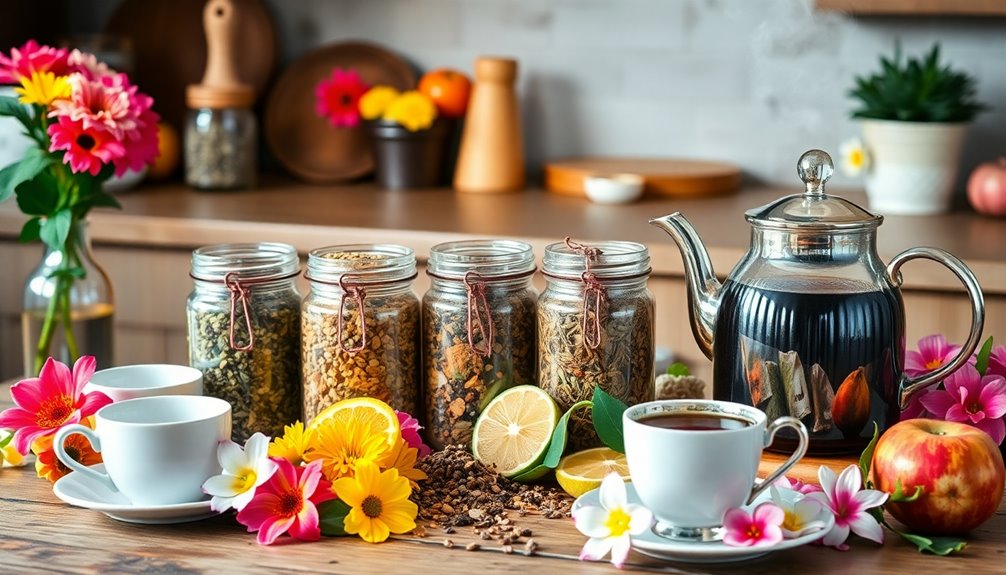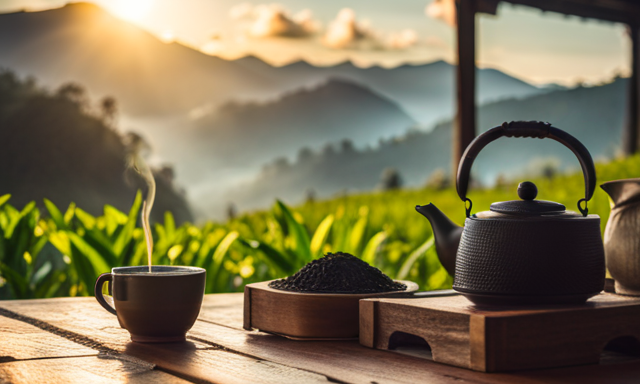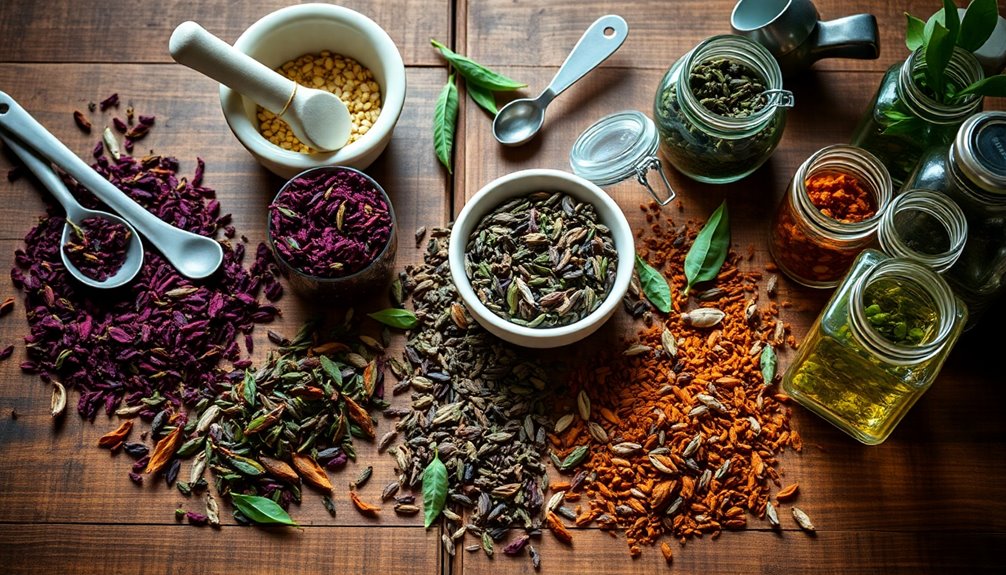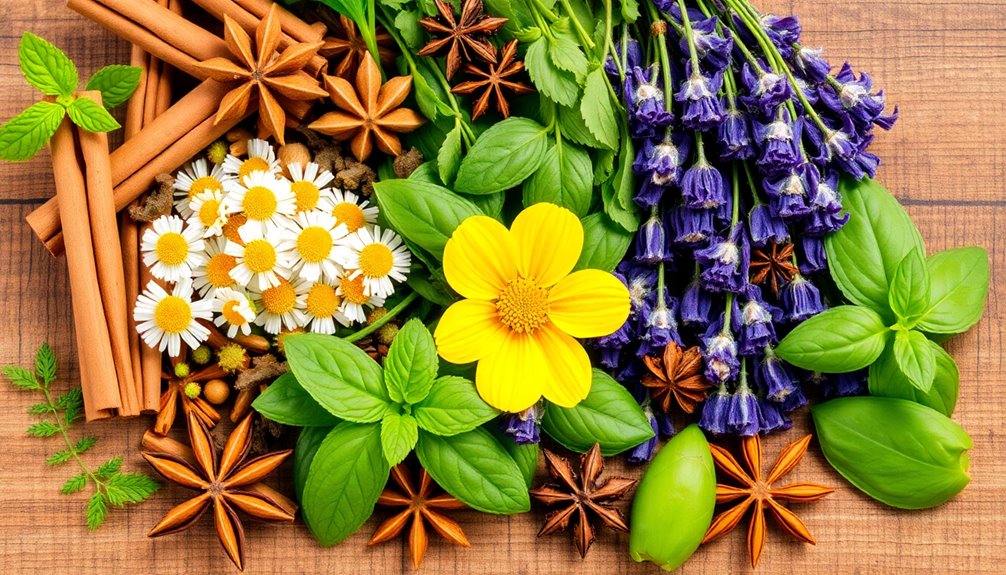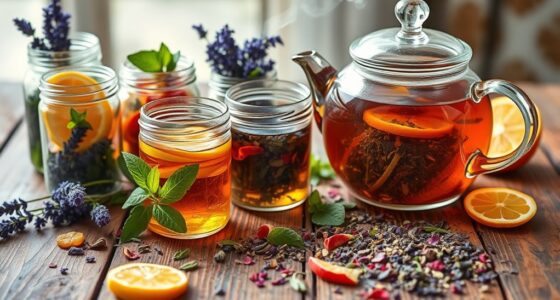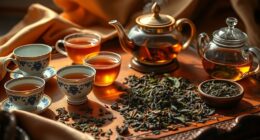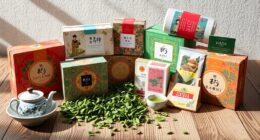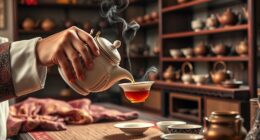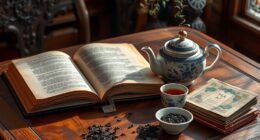You're about to discover the joy of crafting your own custom tea blends! Here are five simple recipes to try:
- Calming Chamomile: Combine chamomile, lavender, and a pinch of vanilla.
- Energizing Mint: Mix peppermint leaves, lemon peel, and green tea.
- Warm Cinnamon Spice: Blend rooibos, cinnamon, and ginger.
- Fruity Hibiscus: Combine dried hibiscus, apple pieces, and a dash of orange zest.
- Herbal Immune Boost: Mix echinacea, elderberry, and lemon balm.
Experiment with these blends and adjust them to fit your taste. Exciting flavors await you, so stick around to explore more delicious combinations!
Key Takeaways
- Chamomile Lavender Relaxation Blend: Combine equal parts chamomile and lavender for a soothing tea ideal for promoting relaxation and sleep quality.
- Mint Citrus Refreshing Blend: Mix fresh mint with dried lemon peel for a refreshing summer tea that invigorates the senses and provides a bright flavor.
- Spiced Apple Comfort Blend: Blend dried apple pieces with cinnamon and ginger for a warming fall tea that offers comfort and warmth during cooler months.
- Echinacea Immune Boost Blend: Combine echinacea and elderberry for a health-focused tea that supports immune function, especially useful during cold and flu season.
- Rooibos Vanilla Sweet Blend: Mix rooibos with a hint of vanilla for a naturally sweet, caffeine-free tea that can be enjoyed any time of the day.
Introduction
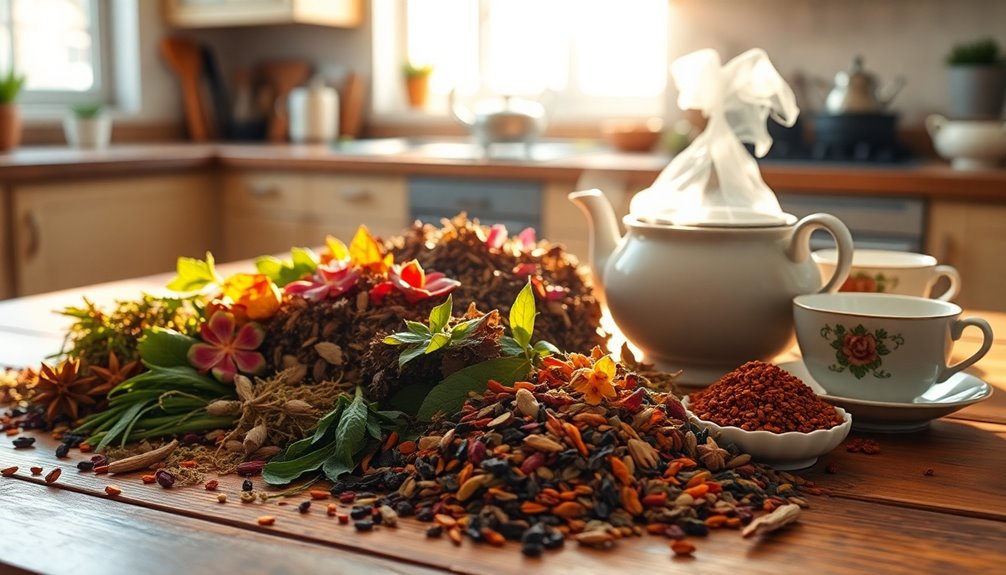
When you explore the world of custom tea blends, you unlock a realm of flavor and wellness tailored just for you. Imagine creating your own unique combinations of dried herbs, spices, and fruits! With custom tea blends, you can choose ingredients that match your taste and health goals.
Here are some fun points to consider:
- Flavor Profiles: Each ingredient brings its own taste. You might love the calming effects of chamomile or the invigorating kick from peppermint.
- Health Benefits: Different herbs offer various health perks, from relaxation to energy boosts.
- Simple Recipes: You don't need to be a tea expert! Start with simple recipes that use common ingredients like rooibos or mint.
- Blending Process: You can adjust your blend to be soothing or energizing, depending on your mood.
The best part? You can experiment and discover new favorites!
Gift-Worthy Tea Blend Options
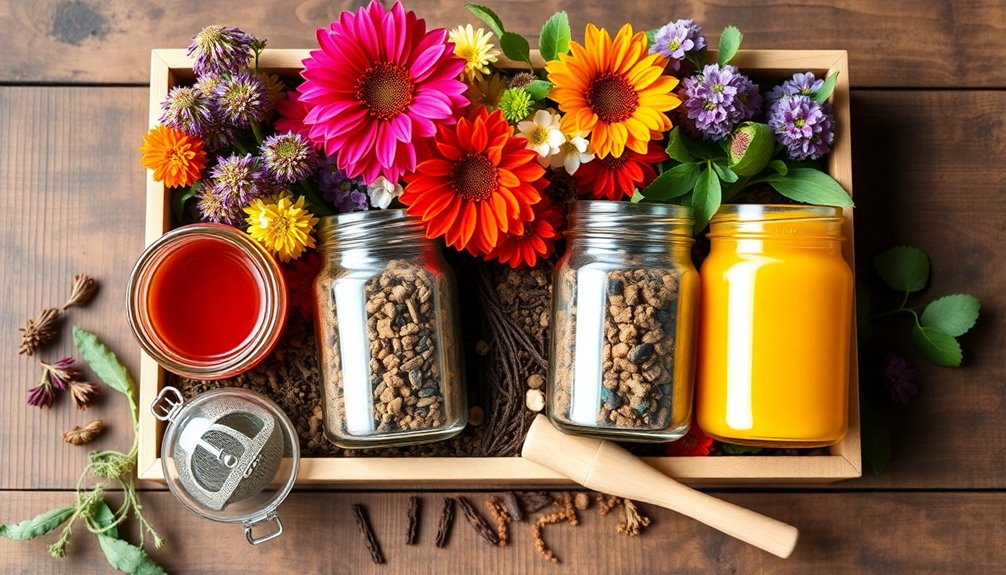
Creating gift-worthy tea blends can transform a simple gesture into a heartfelt experience, especially when you tailor the ingredients to the recipient's tastes. Imagine gifting a tea enthusiast a homemade tea blend that's both thoughtful and unique! Incorporating essential oils like lavender oil can also enhance the calming effects of your tea blend. Additionally, consider the health benefits of various flower teas, such as antioxidants found in chamomile and hibiscus. Green tea is another excellent option that offers unique flavors and health benefits, making your blend even more special. Adding eucalyptus oil can also provide a refreshing twist while promoting respiratory health.
To start, consider using decorative glass jars or corked bottles for an appealing touch. You can include a label that lists the unique ingredients along with brewing instructions. This way, your recipient knows exactly how to enjoy their special blend!
Mix up flavor profiles by adding fun ingredients. For instance, you might blend vanilla with rooibos for a sweet treat or combine chamomile with lavender for a soothing experience.
Don't forget about festive packaging! Use fabric circles and ribbons to make each jar feel extra special during the holidays. These little touches show you care and make the gift stand out. Additionally, consider pairing your tea blends with high-quality honey to enhance the flavor and provide a natural sweetening alternative.
Whether it's a birthday, holiday, or just because, these custom tea blends are perfect thoughtful gifts. With your creativity, you can create delightful blends that will warm hearts and bring smiles!
Herbal Health Benefits Explained
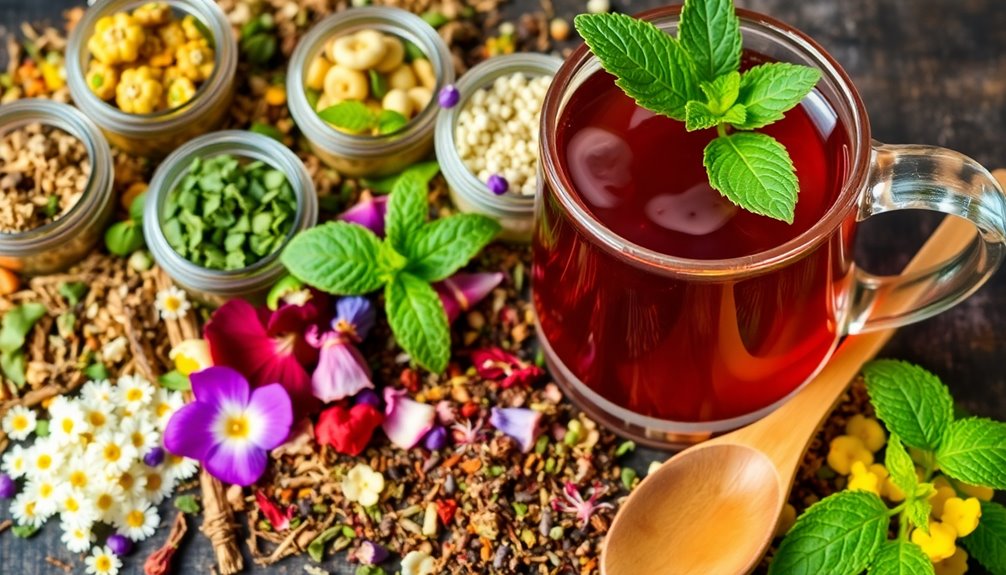
Herbal teas pack a punch when it comes to health benefits, making them a popular choice for those seeking natural remedies.
You'll love how easy it's to create custom blends that not only taste good but also support your well-being.
Here are some fantastic herbal tea benefits you can enjoy:
- Rich in Antioxidants: Herbal teas are loaded with antioxidants, helping your body fight off oxidative stress and stay healthy. Research indicates that these antioxidant effects can combat the damaging effects of free radicals in the body. Additionally, many herbal teas, such as ginger tea, are known for their ability to enhance overall health, which is due to their anti-inflammatory properties. Furthermore, herbal teas like baked kale can provide additional antioxidants that further promote health.
- Calming Effects: Ingredients like chamomile and lavender are fantastic for easing stress and promoting better sleep quality. Drinking these teas can create a soothing ritual that enhances relaxation.
- Digestion Helpers: Ginger and peppermint are great for digestion, making them perfect for relieving bloating and discomfort.
- Immune Boosters: Echinacea and elderberry work wonders for your immune system, especially during cold and flu season.
- Caffeine-Free Options: Most herbal teas are caffeine-free, making them safe and hydrating for everyone in the family.
Additionally, certain herbal teas, like turmeric tea, can provide valuable anti-inflammatory benefits that enhance overall well-being.
Try out different recipes to create your own herbal tea blends.
With these delightful ingredients, you'll not only enjoy a warm cup but also support your health in a fun and flavorful way!
Seasonal Flavor Pairings Highlighted
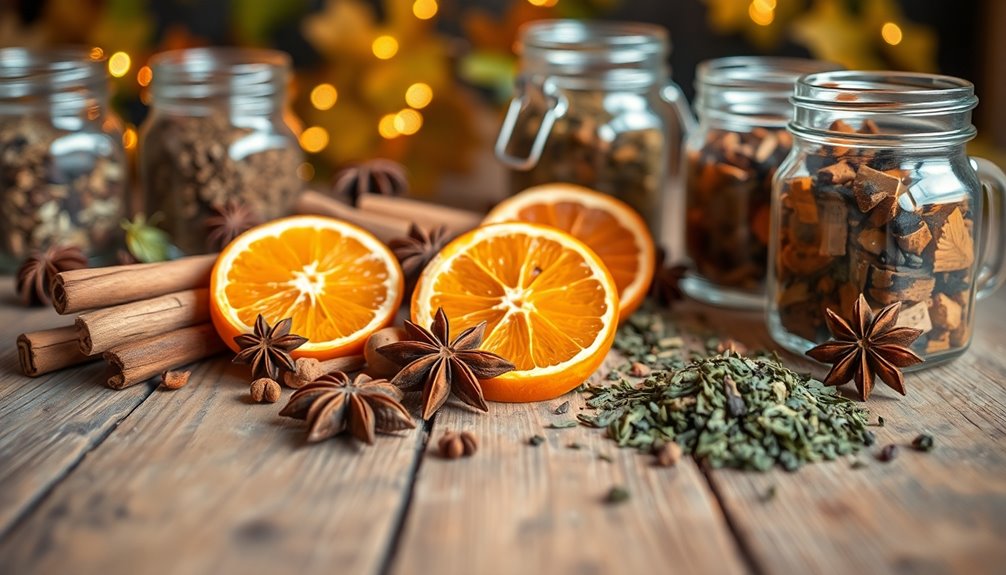
Custom tea blends can be even more enjoyable when you incorporate seasonal flavor pairings.
Let's explore how to bring the changing seasons into your tea!
Spring: Use floral ingredients like chamomile and lavender. They add a refreshing touch, perfect for the vibrant blooms around you.
Summer: Fresh mint and bright citrus fruits, like lemons or oranges, create a lively tea blend.
You'll love the way they dance on your taste buds!
Fall: Warming spices such as cinnamon and ginger make comforting blends that warm you up inside.
Don't forget to add seasonal fruits like apples for a touch of natural sweetness!
Winter: Hearty ingredients like rooibos and cozy herbs create delightful, soothing tea blends.
These comforting blends help you relax after a chilly day.
Ingredient Sourcing Difficulties
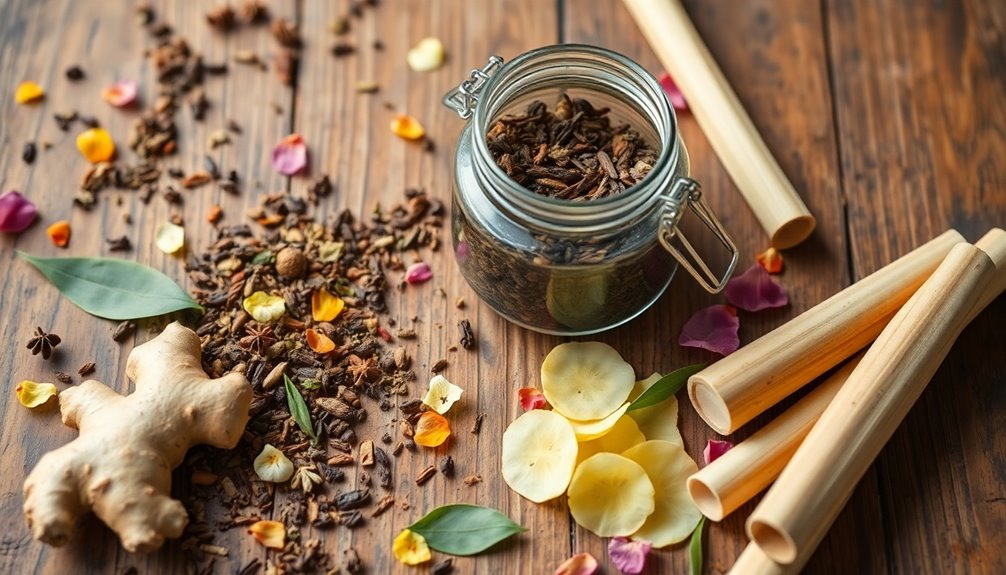
Finding the right ingredients for your tea blends can sometimes be challenging. But don't worry! You've got plenty of options to explore.
Local herbal shops often sell dried herbs in bulk, which makes it easy to find what you need for your tea blends at home. Plus, purchasing by the pound is usually more economical than buying pre-packaged teas. Educational toys can also provide valuable lessons about flavors and ingredients for children during tea blending activities. Additionally, consider incorporating adaptogenic herbs like ashwagandha into your blends for added energy support. Incorporating pet therapy can also enhance emotional well-being, similar to how certain herbs can uplift your mood. Drinking herbal teas like chamomile can also promote relaxation and reduce stress.
If you're looking for something specific, online retailers like Atlantic Spice Company have a wide selection of dried herbs. Just make sure to check their quality and reputation before you buy!
Seasonal availability can also impact what you can find. That's why visiting farmers' markets is a great idea—it can lead you to fresh herbs and support local businesses. Choosing high-quality ingredients is essential, as low-quality tea leaves often result in a more astringent taste.
Incorporating more fresh fruits and vegetables into your diet can enhance the flavor and health benefits of your tea blends.
Here are some tips for ingredient sourcing:
- Check local herbal shops for bulk purchasing.
- Explore online retailers for hard-to-find herbs.
- Visit farmers' markets for seasonal options.
With these strategies, you'll be well on your way to creating delightful tea blends that your family will love. Happy blending!
Practical Applications
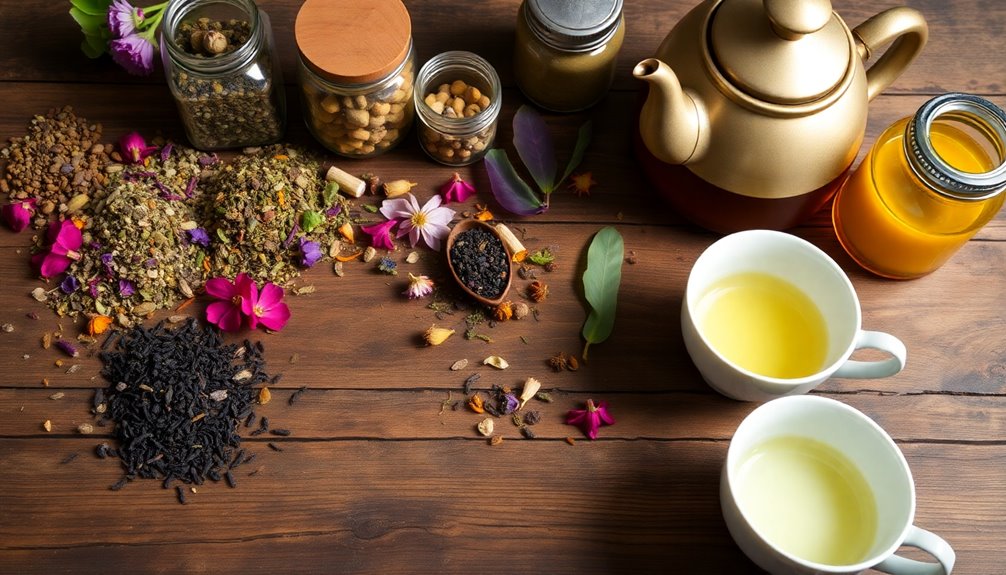
When it comes to creating your own tea blends, starting with a solid foundation is key. Begin with a base ingredient like a pure tea or dried herb, and think about flavor profiles that excite you! You could choose floral notes from chamomile, or the bright zing of citrus from lemon peel.
Here's a simple ratio to remember: 1 part base, 1 part star ingredient, and 1/2 part accent flavors. For example, try combining chamomile (base), lavender (star), and lemon peel (accent) for a delightful blend. Essential oils can also be infused into your tea blends for added benefits, enhancing the overall experience.
When you're experimenting with tea recipes, start small! This way, you can adjust flavors to your liking. Keep an eye on your steeping time, too—5 to 10 minutes is ideal, but longer steeping can lead to bitterness.
Don't forget to use seasonal ingredients! Fresh mint is fantastic in summer, while warming spices like cinnamon are perfect for winter blends. Incorporating specific utensils used in traditional tea ceremonies can enhance the overall experience of your custom blend.
It's all about making custom tea that fits the time of year. So gather your dried herbs, mix, and enjoy the joy of sipping your very own tea creation with family and friends!
Frequently Asked Questions
What Teas Blend Well Together?
When blending teas, you'll find black tea pairs beautifully with spices, while green tea shines with citrus. Herbal teas create calming mixes, and rooibos complements sweet flavors, making your combinations truly delightful and varied.
Can I Make My Own Tea Blend?
Yes, you can definitely make your own tea blend! Start with a base tea, add a couple of star ingredients, and experiment with flavors. Use high-quality ingredients to enhance taste and health benefits. Enjoy the process!
What Is the Ratio of Tea Blends?
When creating tea blends, you'll typically use a ratio of about 50% base ingredients, 30% star ingredients, and 20% accent flavors. Adjusting these proportions helps you customize the taste to your preference.
What Is the Most Popular Tea Blend?
You'll find that Earl Grey stands out as the most popular tea blend. Its unique combination of black tea and bergamot oil creates a citrusy flavor that many tea lovers can't resist. Enjoy it anytime!
Conclusion
Now that you've got these fun tea blend recipes, it's time to get creative! Whether you're making a cozy cup for yourself or a thoughtful gift for a friend, each blend can bring joy and warmth. Remember, experimenting with flavors is part of the fun, so don't be afraid to mix things up! Enjoy the delightful aromas and tastes, and share your new creations with loved ones. Happy brewing, and cheers to your tea adventures!

